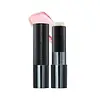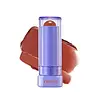What's inside
What's inside
 Key Ingredients
Key Ingredients

 Benefits
Benefits

 Concerns
Concerns

 Ingredients Side-by-side
Ingredients Side-by-side

Diisostearyl Malate
EmollientCaprylic/Capric Triglyceride
MaskingPolyglyceryl-2 Isostearate
EmulsifyingHydrogenated Polyisobutene
EmollientOctyldodecanol
EmollientButyrospermum Parkii Butter
Skin ConditioningMicrocrystalline Wax
Emulsion StabilisingPolyethylene
AbrasiveCeresin
Emulsion Stabilising1,2-Hexanediol
Skin ConditioningEthylhexylglycerin
Skin ConditioningPhenoxyethanol
PreservativeGlycerin
HumectantTocopheryl Acetate
AntioxidantRosa Canina Fruit Oil
EmollientPrunus Armeniaca Kernel Oil
MaskingPersea Gratissima Oil
Skin ConditioningMacadamia Ternifolia Seed Oil
EmollientButylene Glycol
HumectantWater
Skin ConditioningPropylene Glycol
HumectantHydrogenated Lecithin
EmulsifyingCeramide NP
Skin ConditioningAnemarrhena Asphodeloides Root Extract
Skin ConditioningCI 45410
Cosmetic ColorantParfum
MaskingDiisostearyl Malate, Caprylic/Capric Triglyceride, Polyglyceryl-2 Isostearate, Hydrogenated Polyisobutene, Octyldodecanol, Butyrospermum Parkii Butter, Microcrystalline Wax, Polyethylene, Ceresin, 1,2-Hexanediol, Ethylhexylglycerin, Phenoxyethanol, Glycerin, Tocopheryl Acetate, Rosa Canina Fruit Oil, Prunus Armeniaca Kernel Oil, Persea Gratissima Oil, Macadamia Ternifolia Seed Oil, Butylene Glycol, Water, Propylene Glycol, Hydrogenated Lecithin, Ceramide NP, Anemarrhena Asphodeloides Root Extract, CI 45410, Parfum
Polyglyceryl-2 Triisostearate
EmulsifyingBis-Behenyl/Isostearyl/Phytosteryl Dimer Dilinoleyl Dimer Dilinoleate
EmollientHydrogenated Polyisobutene
EmollientSynthetic Wax
AbrasiveOctyldodecanol
EmollientPropylene Glycol Dibenzoate
Skin ConditioningGlycerin
HumectantEthylhexyl Hydroxystearate
EmollientSimmondsia Chinensis Seed Oil
Emollient1,2-Hexanediol
Skin ConditioningSorbitan Isostearate
EmulsifyingRicinus Communis Seed Oil
MaskingDisteardimonium Hectorite
StabilisingButyrospermum Parkii Butter
Skin ConditioningTitanium Dioxide
Cosmetic ColorantPunica Granatum Flower Extract
Skin ConditioningMicrocrystalline Wax
Emulsion StabilisingCI 77491
Cosmetic ColorantTocopheryl Acetate
AntioxidantPropylene Carbonate
SolventPolyglyceryl-3 Diisostearate
EmulsifyingCI 77492
Cosmetic ColorantCeramide NP
Skin ConditioningCI 77499
Cosmetic ColorantParfum
MaskingCI 15850
Cosmetic ColorantSorbitan Olivate
EmulsifyingPhytosphingosine
Skin ConditioningTriethoxycaprylylsilane
CI 15985
Cosmetic ColorantAluminum Hydroxide
EmollientSodium Hyaluronate
HumectantLimonene
PerfumingLinalool
PerfumingBenzyl Salicylate
PerfumingHydroxycitronellal
PerfumingHexyl Cinnamal
PerfumingWater
Skin ConditioningGeraniol
PerfumingCitronellol
PerfumingCaproic Acid
CleansingOpuntia Coccinellifera Fruit Extract
Skin ConditioningHydrolyzed Sodium Hyaluronate
Skin ConditioningRosa Damascena Flower Water
MaskingSodium Hyaluronate Crosspolymer
HumectantPotassium Hyaluronate
Skin ConditioningHydroxypropyltrimonium Hyaluronate
Hydrolyzed Hyaluronic Acid
HumectantHyaluronic Acid
HumectantSodium Acetylated Hyaluronate
HumectantPolyglyceryl-2 Triisostearate, Bis-Behenyl/Isostearyl/Phytosteryl Dimer Dilinoleyl Dimer Dilinoleate, Hydrogenated Polyisobutene, Synthetic Wax, Octyldodecanol, Propylene Glycol Dibenzoate, Glycerin, Ethylhexyl Hydroxystearate, Simmondsia Chinensis Seed Oil, 1,2-Hexanediol, Sorbitan Isostearate, Ricinus Communis Seed Oil, Disteardimonium Hectorite, Butyrospermum Parkii Butter, Titanium Dioxide, Punica Granatum Flower Extract, Microcrystalline Wax, CI 77491, Tocopheryl Acetate, Propylene Carbonate, Polyglyceryl-3 Diisostearate, CI 77492, Ceramide NP, CI 77499, Parfum, CI 15850, Sorbitan Olivate, Phytosphingosine, Triethoxycaprylylsilane, CI 15985, Aluminum Hydroxide, Sodium Hyaluronate, Limonene, Linalool, Benzyl Salicylate, Hydroxycitronellal, Hexyl Cinnamal, Water, Geraniol, Citronellol, Caproic Acid, Opuntia Coccinellifera Fruit Extract, Hydrolyzed Sodium Hyaluronate, Rosa Damascena Flower Water, Sodium Hyaluronate Crosspolymer, Potassium Hyaluronate, Hydroxypropyltrimonium Hyaluronate, Hydrolyzed Hyaluronic Acid, Hyaluronic Acid, Sodium Acetylated Hyaluronate
Ingredients Explained
These ingredients are found in both products.
Ingredients higher up in an ingredient list are typically present in a larger amount.
1,2-Hexanediol is a synthetic liquid and another multi-functional powerhouse.
It is a:
- Humectant, drawing moisture into the skin
- Emollient, helping to soften skin
- Solvent, dispersing and stabilizing formulas
- Preservative booster, enhancing the antimicrobial activity of other preservatives
This ingredient is also known as shea butter. It is an effective skin hydrator and emollient.
Emollients help soothe and soften your skin. It does this by creating a protective film on your skin. This barrier helps trap moisture and keeps your skin hydrated. Emollients may be effective at treating dry or itchy skin.
Shea butter is rich in antioxidants. Antioxidants help fight free-radicals, or molecules that may harm the body. It is also full of fatty acids including stearic acid and linoleic acid. These acids help replenish the skin and keep skin moisturized.
While Shea Butter has an SPF rating of about 3-4, it is not a sunscreen replacement.
Shea butter may not be fungal acne safe. We recommend speaking with a professional if you have any concerns.
Learn more about Butyrospermum Parkii ButterCeramide NP is a type of ceramide.
Ceramides are intercellular lipids naturally found in our skin that bonds dead skin cells together to create a barrier. They are known for their ability to hold water and thus are a great ingredient for dry skin.
Ceramides are an important building block for our skin barrier. A stronger barrier helps the skin look more firm and hydrated. By bolstering the skin ceramides act as a barrier against irritating ingredients. This can help with inflammation as well.
If you would like to eat ceramides, sweet potatoes contain a small amount.
Read more about other common types of ceramides here:
Ceramide AP
Ceramide EOP
Glycerin is already naturally found in your skin. It helps moisturize and protect your skin.
A study from 2016 found glycerin to be more effective as a humectant than AHAs and hyaluronic acid.
As a humectant, it helps the skin stay hydrated by pulling moisture to your skin. The low molecular weight of glycerin allows it to pull moisture into the deeper layers of your skin.
Hydrated skin improves your skin barrier; Your skin barrier helps protect against irritants and bacteria.
Glycerin has also been found to have antimicrobial and antiviral properties. Due to these properties, glycerin is often used in wound and burn treatments.
In cosmetics, glycerin is usually derived from plants such as soybean or palm. However, it can also be sourced from animals, such as tallow or animal fat.
This ingredient is organic, colorless, odorless, and non-toxic.
Glycerin is the name for this ingredient in American English. British English uses Glycerol/Glycerine.
Learn more about GlycerinHydrogenated Polyisobutene is a synthetic polymer. Polymers are compounds with high molecular weight. Hydrogenated Polyisobutene is an emollient and texture enhancer.
In one study, Hydrogenated Polyisobutene showed better skin hydration levels than Caprylic/Capric Triglyceride. As an emollient, it helps keep your skin soft and hydrated by trapping moisture in.
Hydrogenated Polyisobutene is often used as a mineral oil replacement.
Learn more about Hydrogenated PolyisobuteneMicrocrystalline Wax is created by de-oiling petroleum. It is highly refined and purified before being added to cosmetics.
Microcrystalline Wax is used to enhance the texture and create even consistency. It helps stabilize a product by preventing ingredients from separating.
Octyldodecanol is a fatty alcohol. It is primarily used to enhance the texture of products.
As an emulsifier, Octyldodecanol helps prevent the oils and waters from separating. It also prevents ingredients from creating foam when shaken.
Octyldodecanol is created by reducing fatty acid to an alcohol.
Due to its high molecular weight, it does not get absorbed into the skin.
Learn more about OctyldodecanolParfum is a catch-all term for an ingredient or more that is used to give a scent to products.
Also called "fragrance", this ingredient can be a blend of hundreds of chemicals or plant oils. This means every product with "fragrance" or "parfum" in the ingredients list is a different mixture.
For instance, Habanolide is a proprietary trade name for a specific aroma chemical. When used as a fragrance ingredient in cosmetics, most aroma chemicals fall under the broad labeling category of “FRAGRANCE” or “PARFUM” according to EU and US regulations.
The term 'parfum' or 'fragrance' is not regulated in many countries. In many cases, it is up to the brand to define this term.
For instance, many brands choose to label themselves as "fragrance-free" because they are not using synthetic fragrances. However, their products may still contain ingredients such as essential oils that are considered a fragrance by INCI standards.
One example is Calendula flower extract. Calendula is an essential oil that still imparts a scent or 'fragrance'.
Depending on the blend, the ingredients in the mixture can cause allergies and sensitivities on the skin. Some ingredients that are known EU allergens include linalool and citronellol.
Parfum can also be used to mask or cover an unpleasant scent.
The bottom line is: not all fragrances/parfum/ingredients are created equally. If you are worried about fragrances, we recommend taking a closer look at an ingredient. And of course, we always recommend speaking with a professional.
Learn more about ParfumTocopheryl Acetate is AKA Vitamin E. It is an antioxidant and protects your skin from free radicals. Free radicals damage the skin by breaking down collagen.
One study found using Tocopheryl Acetate with Vitamin C decreased the number of sunburned cells.
Tocopheryl Acetate is commonly found in both skincare and dietary supplements.
Learn more about Tocopheryl AcetateWater. It's the most common cosmetic ingredient of all. You'll usually see it at the top of ingredient lists, meaning that it makes up the largest part of the product.
So why is it so popular? Water most often acts as a solvent - this means that it helps dissolve other ingredients into the formulation.
You'll also recognize water as that liquid we all need to stay alive. If you see this, drink a glass of water. Stay hydrated!
Learn more about Water